Brown recluse spiders are members of a spider species known as fiddleback spiders or violin spiders, due to a dark violin-shaped pattern on the dorsal side of its back (its carapace). The brown recluse spider mostly avoids confrontation and attention; hence the recluse part of its name. Incidents (bites) are in fact accidents, as it is not aggressive towards humans.
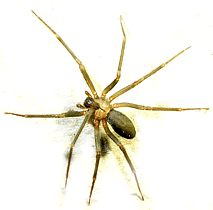 The Latin name of the brown recluse spider is Loxosceles reclusa. It belongs to a group of spider also known as fiddleback spiders or violin spiders due to a dark fiddle-shaped (or violin-shaped) pattern on the dorsal side of its carapace.
The Latin name of the brown recluse spider is Loxosceles reclusa. It belongs to a group of spider also known as fiddleback spiders or violin spiders due to a dark fiddle-shaped (or violin-shaped) pattern on the dorsal side of its carapace.
Species are often named after some of their traits. A person living in recluse prefers to hide away from attention, and the same is the case with the brown recluse spider; it prefers not being disturbed by humans.
The spider is brown to a golden brown. Its size is from 0.25 inch to 0.75 inches but may grow larger in some cases. It has short hairs on its body. The brown recluse spider has six eyes arranged in three pairs, which is less than the usual eight eyes found in most spiders. Males and females are similar in appearance while younger specimens are a bit lighter in their color. In the picture section, there’s plenty of pictures of the brown recluse spider.
What Does a Bite from a Brown Recluse Look Like?
Table of Contents
The brown recluse spider is not aggressive and only bites if something attacks it, presses it against its skin, or threatens its livelihood somehow. Luckily, brown recluse spiders are more peaceful than most people believe, and almost all bites on humans occur when the spider is caught up against the skin. Bites occur periodically as it likes hiding in shoes and clothes.
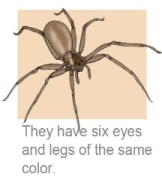
Bites may vary in severity from no symptoms at all to very severe reactions such as renal (kidney) failure and ultimately death1. Unfortunately, there’s currently no effective therapy for brown recluse bites2.
No conclusive test for identifying envenomations caused by the brown recluse spider are available3 – and because loxoscelism can look like many severe types of pathologies, clinicians have to be very careful in their diagnosis of injuries.
Brown Recluse Spider Life Cycle
Eggs are deposited in sheltered areas and in off white egg sacks. The eggs have a diameter of about 0.3 inches and contain 40 to 50 eggs. The egg sack is white. Spiderlings molt five to eight times before adulthood. The molted skin looks very rigid in their structure and can be used for identification by experienced entomologists. The brown recluse spider can reach an age of two to four years.
Where Do You Find Brown Recluse Spiders?
The Brown Recluse inhabit the south and south-central states from Georgia through Texas and north to Wisconsin. There are no brown recluse spider populations in California or Florida.
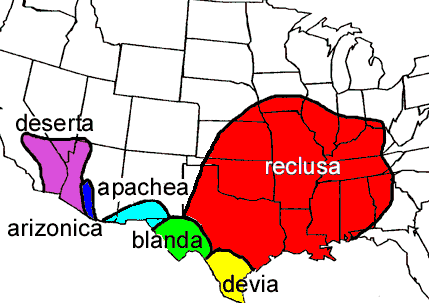
Individual specimens are however transported to California and Florida from time to time, but they probably don’t reproduce in either California or Florida.
There’s a lot of discussion going on about the distribution of the spider. Some will say that it’s confined to a few states in the southern parts of the midwest while other thinks it can be found in all the following states: Texas, Nebraska, Kansas, Iowa, Missouri, Oklahoma, Tennessee, Alabama, Georgia, Mississippi, Louisiana, Kentucky, Ohio, Arkansas, West Virginia, Indiana, Illinois, and West Virginia. When I write this some might say that it is probably not true and the specimens found in places like Ohio and West Virginia are not endemic to these areas, not a part of a thriving population – and must have been transported there somehow.
In some of these states, it will only occur in a confined area and small populations. Bites from the brown recluse have also been reported from both Florida and California. This might be due to some imported specimens but more likely it is due to misidentification of the bite. A recorded population of the spider has neither been observed in Florida nor California. However there are some other Loxosceles spiders found in the eastern California desert, but this is not the brown recluse or Loxosceles reclusa.
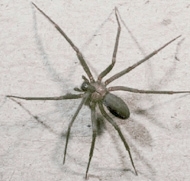 However there are some other Loxosceles spiders found in the eastern California desert, but it is not the brown recluse. The name recluse means that it prefers to hide whenever possible and any place which has been undisturbed for some period. It is most often found in barns, woodpiles or beneath anything lying on the ground. It’s also found in basements or garages behind boxes, in old clothing or inside papers, tires.
However there are some other Loxosceles spiders found in the eastern California desert, but it is not the brown recluse. The name recluse means that it prefers to hide whenever possible and any place which has been undisturbed for some period. It is most often found in barns, woodpiles or beneath anything lying on the ground. It’s also found in basements or garages behind boxes, in old clothing or inside papers, tires.
It’s almost impossible to prevent the brown recluse as well as other spiders from migrating indoor. The best way for minimizing the risk of encountering the brown recluse spider indoor is to seal holes and cracks in the house and to keep debris and other material away from the foundation of the house.
Identification
It can be challenging to determine whether or not a spider is a brown recluse spider. Wolf spiders are similar in appearance when it comes to the markings on its back, but wolf spiders are hairy and generally more substantial than the brown recluse. The best way to identify a brown recluse spider is to look at its eyes. If it only has six eyes, it’s probably a recluse.
Misidentification of spiders as brown recluse spiders are killing thousands of spiders every year, as people, understandably, won’t take any chances with a possible brown recluse.
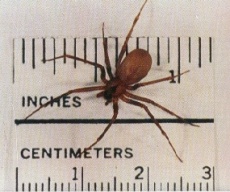 In general, the toxicity of spiders is much less than what people tend to think. Ed Nieuwenhuys has done an excellent review6 concerning the myths about the toxicity of poisonous spiders.
In general, the toxicity of spiders is much less than what people tend to think. Ed Nieuwenhuys has done an excellent review6 concerning the myths about the toxicity of poisonous spiders.
Brown Recluse Spider Bites
Most domestic spiders in the US are not substantially venomous to man and does not constitute a threat. Exceptions are the widow spiders and the brown spiders.
The brown recluse spider can be found in many southern states of North America, in some parts of Europe and Israel. The spider has extended its habitat to include homes and garages and encounters between man and brown recluse spider has become more likely.
The venom from a brown recluse spider is cytotoxic and contains several compounds of which some can cause tissue destruction and hemolysis or abnormal breakdown of red blood cells.
Consequences of envenomations from the bite of the brown recluse spider (please notice that not all bites automatically lead to an envenomation) vary in range from light itching to death1. The effect of a bite also depends on the amount of venom injected. In so-called dry bites, no venom is injected. The ability of the spider to cause an envenomation also depends on its size. According to a study (Vetter and Barger 2002), only around 400 of 2055 brown recluse spiders were estimated as significant enough to cause envenomations.
It is a problem that diagnosis of spider bites often are based on evolved symptoms rather than from a spider collected from the incident. This has led to doctors in places like California, where there’s no population of the brown recluse spider, to be confronted with medical cases (patients) with alleged brown recluse spider bites.
Dermonecrotic wounds of uncertain origin are often attributed to the brown recluse spider, Loxosceles reclusa2. Seen from both the patients and the spiders perspective, this is unsatisfying.
The bite itself is usually not accompanied by any pain, and the victim is often unaware of the bite until the bite site becomes red and swollen. In most cases, there are no complications, and the wound heals within two to three weeks. In severe cases, a necrotic lesion evolves. The wound will appear bluish with irregular edges. As the venom propagates in the body of the victim, it destroys tissue, and the wound expands.
Can brown Recluse spiders kill you?
In a Brazilian study, only 1.5% of the investigated 267 cases died from envenomation by the brown recluse spider. 4.6 % of patients observed acute renal failure, and almost all patients experienced intravascular haemolysis3. Other surveys show that deaths from the brown recluse spider are infrequent.
Venom
The venom from a brown recluse spider is extremely venomous. Because of its venom, the brown recluse spider is perhaps considered one of the most medically necessary groups of spiders. Envenomations can result in dermonecrosis and sometimes general systemic illness that can be life-threatening for especially elderly and children.
Loxoscelism
The term loxoscelism refers to the condition caused by envenomations from spiders of the genus Loxosceles.
Brown recluse spiders can cause necrotic injuries on the skin due to an enzyme named sphingomyelinase D found in the spider. Sphingomyelinase D is also found in several types of bacteria so damages caused by bacterial infections can resemble damages caused by the spider.
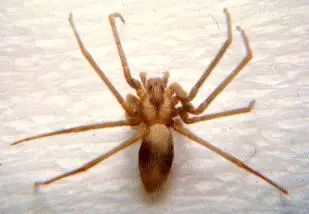 Associations between skin injuries of the dermonecrosis type (flesh-eating disease) and Loxosceles was first made in the late 19th century. The first scientific proof of a connection was made as late as 1947. Since then, scientists have tried to treat patients with dermonecrosis, but no effective therapy has yet been found.
Associations between skin injuries of the dermonecrosis type (flesh-eating disease) and Loxosceles was first made in the late 19th century. The first scientific proof of a connection was made as late as 1947. Since then, scientists have tried to treat patients with dermonecrosis, but no effective therapy has yet been found.
A lesion caused by the venom results from direct effects of the venom. The venom has an impact on both a cellular and extracellular level. The outcome depends on multiple factors that are not quite well understood. This is also why no curing therapy is available. To help patients suffering from loxoscelism or bites from recluse spiders, other treatment methods are however applied. Unfortunately, they are not able to prevent someone from dying from brown recluse spider bites from time to time.
Other web resources about the brown recluse spider
References
- Dyachenko P et al., “Epidemiological and clinical manifestations of patients hospitalized with a brown recluse spider bite.”
- Swanson DL et al., “Loxoscelism” CLINICS IN DERMATOLOGY Volume 24 (3) page. 213-221 (2006)
- Wendell RP, “Brown recluse spiders: A review to help guide physicians in nonendemic areas.”
- Pauli I et al. “The efficacy of antivenom in loxoscelism treatment” TOXICON 48 (2): page 123-137 (2006)
- ME Peterson, “Brown Spider Envenomation” CLINICAL TECHNIQUES IN SMALL ANIMAL PRACTICE Vol. 21 (4): 191-193 (2006)
- Ed Nieuwenhuys: The demystification of the toxicity of spiders (PDF)
